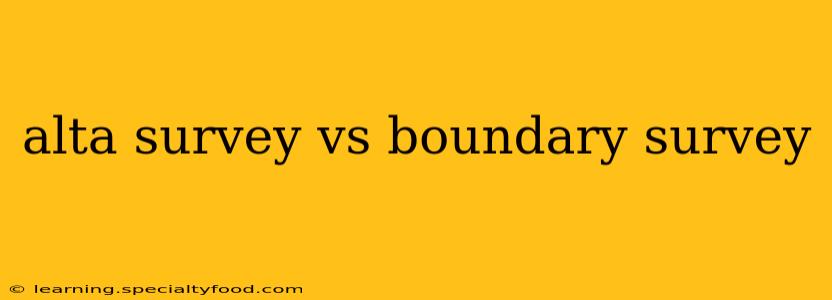Choosing the right type of land survey is crucial for various real estate and construction projects. Two common types are Alta surveys and boundary surveys. While both involve mapping land, they serve distinct purposes and have different levels of detail. This article will clarify the key differences between Alta surveys and boundary surveys, helping you understand which one best suits your needs.
What is an Alta Survey?
An Alta survey, formally known as an ALTA/NSPS Land Title Survey, is a comprehensive land survey that goes beyond simply establishing property boundaries. It's designed to meet the specific requirements of the American Land Title Association (ALTA) and the National Society of Professional Surveyors (NSPS). This standardized survey provides a detailed depiction of the property, including improvements, easements, encroachments, and potential title issues. It's commonly required by lenders and title insurance companies to ensure the property's boundaries are accurately represented and there are no significant risks associated with the title.
Key Features of an Alta Survey:
- Detailed Property Boundaries: Precisely defines the property lines.
- Improvements: Shows the location and dimensions of all structures on the property.
- Easements: Identifies any easements affecting the property (e.g., utility lines, access rights).
- Encroachments: Highlights any encroachments onto or from neighboring properties.
- Title Issues: Points out potential title problems that could affect ownership or transfer of the property.
- Certification: Includes a surveyor's certification verifying the accuracy of the survey.
What is a Boundary Survey?
A boundary survey, also known as a property line survey, primarily focuses on establishing the legal boundaries of a property. While it may include some details about improvements, its main objective is to define the limits of land ownership. This type of survey is often less extensive than an ALTA survey and may not address potential title issues in the same depth. It’s useful for various purposes, including determining property lines for fencing, construction, or property division.
Key Features of a Boundary Survey:
- Property Line Determination: Clearly establishes the legal boundaries of the property.
- Monumentation: Identifies and locates boundary markers (monuments).
- Basic Improvements: May include a basic representation of buildings and other structures, but typically less detailed than an Alta survey.
- Less Comprehensive: Does not typically include detailed information about easements, encroachments, or potential title issues.
Alta Survey vs. Boundary Survey: A Comparison Table
| Feature | Alta Survey | Boundary Survey |
|---|---|---|
| Purpose | Determine property boundaries and potential title issues for lenders and title companies | Establish property boundaries |
| Scope | Comprehensive, detailed | Less comprehensive, focused on boundaries |
| Improvements | Detailed representation | Basic representation |
| Easements | Identified and depicted | May or may not be included |
| Encroachments | Identified and depicted | May or may not be included |
| Title Issues | Identified and addressed | Typically not addressed |
| Certification | Required | May or may not be included |
What is the difference between a Boundary Survey and a Topographic Survey?
This is a question often asked alongside comparing Alta and boundary surveys. A topographic survey differs significantly. It focuses on the terrain's physical features, including elevations, contours, and natural features. While it might show property boundaries, its primary purpose isn't boundary definition but rather creating a detailed representation of the land's topography for purposes like construction planning or engineering projects.
When is an Alta Survey Required?
Alta surveys are typically required when:
- Obtaining a mortgage: Lenders often mandate Alta surveys to minimize risk.
- Transferring property ownership: Title insurance companies usually require them.
- Significant construction or development: To ensure no boundary issues exist.
When is a Boundary Survey Required?
Boundary surveys are appropriate for:
- Fencing: Determining property lines for fence placement.
- Construction projects: Defining buildable areas.
- Property division: Establishing boundaries for subdivided lots.
- Resolving boundary disputes: Clarifying ownership lines.
Conclusion
The choice between an Alta survey and a boundary survey depends entirely on your specific needs. If you're dealing with a mortgage, title insurance, or major construction projects, an Alta survey's comprehensive detail is essential. For simpler projects like fencing or resolving minor boundary disputes, a boundary survey may suffice. Consulting with a qualified land surveyor is crucial to determine the appropriate type of survey for your project. They can provide expert advice and ensure you receive the necessary information for your specific circumstances.
